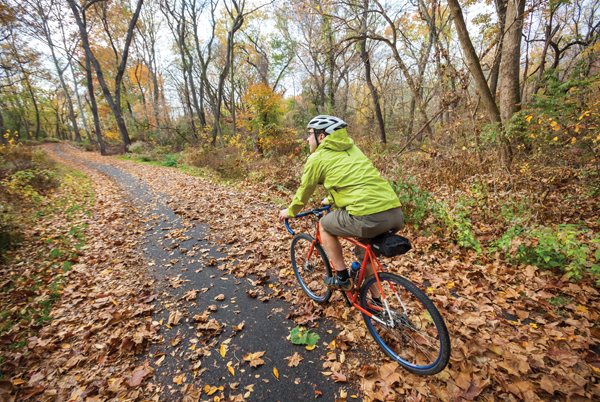Trails Program Closes the Loop
by Alex Jones
The city of Camden sits adjacent to affluent communities in New Jersey and across the river from its sister city of Philadelphia, but, as one of the poorest cities in the country, it remains a world away.
The Circuit Trails network could help change that. Once complete, it will be the nation’s largest network of multipurpose trails, connecting and expanding 300 or so miles of trails in the Philadelphia metro area. Fifty new miles are currently being built, but the project is a long-term, collaborative one: The vision is for at least 20 new miles to be built each year, with 750 miles of interconnected trails once it’s completed around 2038.
Camden native Olivia Glenn, the South Jersey metro regional manager at the New Jersey Conservation Foundation who also serves as the New Jersey vice chair of the Circuit Trails Network, has high hopes for what that means for her city.
“The [Circuit Trails] is a network that serves everybody, from some of the poorest to the most affluent neighborhoods—that’s really important to me, personally,” Glenn says. “That makes it a really important asset to our region.”
Nearly 80 percent of the population of Philadelphia’s five-county metro area and the corresponding counties on the east side of the river—Camden, Gloucester, Burlington and Mercer—live within two miles of the Circuit Trails.
Glenn says that collaboration among regional organizations makes the region’s goals for transportation, accessibility and sustainability much more achievable.
“You don’t optimize your success when you have one municipality or one trail group fighting over the same pot of money as another,” she says. “It’s brought us all together to look at building the 750-mile network in a really strategic way.”
More than 65 groups, including the Pennsylvania Environmental Council, the New Jersey Conservation Foundation and the Bicycle Coalition of Greater Philadelphia, are working together to achieve their goal, rather than competing with each other to fund individual projects.
This top-to-bottom collaboration, from the Delaware Valley Regional Planning Commission to municipalities and nonprofits, has changed how trails projects are conceived and funded: Now, they’re planned with the same consideration as roads and highways—and they’re viewed as just as important.
“We’re thinking about [multipurpose trails] as something we need to have, and we’ll plan for them accordingly and fund them accordingly,” says Patrick Starr, executive vice president at the Pennsylvania Environmental Council and Pennsylvania vice chair of the Circuit Trails Coalition.
And the Circuit Trails isn’t just about commuting and recreation. Environmental and social benefits, such as watershed protection and urban youth education, are being encouraged as a component of the Circuit Trails by funders such as the William Penn Foundation. Research from the nonprofit Alliance for Biking & Walking shows that strong trails networks can improve health outcomes, attract residents and tourism, increase property values and raise awareness of local waterways.
“[The Circuit] gets people to experience the out of doors and enjoy nature,” Starr says. “Even though we live in a crowded metropolitan area of 5 million-plus people, we get to have quiet, intimate experiences outdoors because of some of the trails and the way they’re located.”









